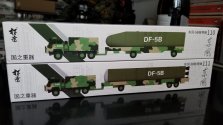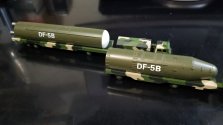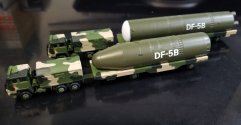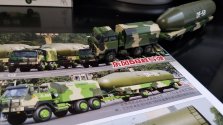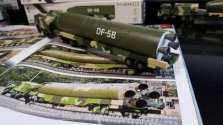When can we see the HQ-26 on board?Aslında, 4 ülke kurs ortasında müdahale gerçekleştirme kabiliyetine sahiptir. Bunlar: ABD, Rusya, Çin ve Hindistan. Tam olarak ASAT yeteneklerine sahip 4 ülkenin küçük kulübü. Teoride, yörüngedeki uyduları başarılı bir şekilde vurabildikleri için, bir füzenin balistik yörüngesinin ortasında başarılı bir önleme şansı oldukça yüksektir. Ancak gerçek anlamda, yalnızca Çin ve ABD, anti-balistik müdahaleyi başarıyla test etti.
Diğer ülkeleri görmezden geleceğim ve Çin'e odaklanacağım. Amerikalıların dünyadaki en gelişmiş BMD'ye sahip olup olmadığını bilmiyorum, ama gerçek şu ki Çin, anti-balistik yeteneklerde Amerikalılara yaslanıyor.
Orta kurs balistik yeteneklerimiz var:
HQ-19 [THAAD muadili]
HQ-26 [SM-3 muadili]
Her üç füze de uzun menzilli anti-balistik füze yetenekleri için tasarlanmıştır. Çin'in yerli füzesavar sistemleri, anti-balistik olanlar bile artık olgunluğa yaklaşıyor. Örneğin, Çin'in ilk büyük başarısı, düşman füzelerini vur-öldür yoluyla imha etmek için tasarlanmış bir kinetik ölüm aracının (KKV) 1999'daki başarılı testiydi. Bu arada Çin, KKV'leri kullanan HQ-19 ve HQ-26 olmak üzere iki farklı füzesavar sistemi geliştirdi. İlk sistem olan HQ-19, THAAD'ın Çin eşdeğeri olarak tasarlandı ve 2018'de konuşlandırıldı, ancak testler 2003'te başladı. HQ-26, geliştirmeye biraz sonra girdi, ancak 2016'da uçuş testlerine girdiği bildirildi. .
HQ-26'nın menzili 2000 km olduğunu iddia ediyor, bu menzil onu sadece 2500 km menzile sahip SM-3'ün Blok IIA versiyonundan sonra ikinci bir önleyici olarak yerleştiriyor. ABD'li bir diplomat, Çin'in Nansha Adaları ve Yongxing Adası'na bazı füzeler yerleştirdiğini iddia ediyor. Bazı analizler, kapsamlı hava savunma sisteminin Güney Çin Denizi'nde CSA-6B, HQ-9 ve HQ-26 aracılığıyla entegre edildiğini ve bölgedeki ABD kuvvetleriyle başa çıkma gücünü artırdığını bildirdi. HQ-26, SM-3'e benzer bir deniz önleme aracını garanti eden Type 055'e kurulabilen bir füzedir.
HQ-19'un menzili, oldukça tartışmalı olan 1000-3000 km olduğunu iddia ediyor. 2000 km menzili bile düşünüyorum, bunun üzerinde şüphelerim var ama bu füzenin gelişiminin 1990'lara dayandığını ve X-band faz dizili radarının 4000 km mesafedeki hedefleri tespit edebildiğini belirtmek isterim. Bu seri hala bir ara ve terminal kesişimi gerçekleştirmeyi başarır, bu da onu THAAD'ın üzerine çıkarır, HQ-19 lehine bir faktör, KKV araçlarına sahip olmasıdır. HQ-19, uyduların yanı sıra füzeleri de düşürme yeteneğine sahip çift amaçlı bir KKV savaş başlığı ile donanmıştır. Bildiğim kadarıyla Çin, 5 Şubat 2018'de topraklarında 4. kara konuşlu füze önleme testi gerçekleştirdi ve amacına ulaştığını bildirdi.
You are using an out of date browser. It may not display this or other websites correctly.
You should upgrade or use an alternative browser.
You should upgrade or use an alternative browser.
China Ballistic Missiles and Nuclear Arms Thread
- Thread starter peace_lover
- Start date
- Status
- Not open for further replies.
That's an answer I don't know. The 2nd Type 055 ship, although it was already commissioned before, only had its combat capacity fully installed a few weeks ago, probably the HQ-26 that must have already left the development stage, it may be that it is installed on the first two ships of the class that came into service. It depends on the missile's development status, if the missile has finished its development, the integration must already be happening, if not yet, the missile must complete the development in the medium term (2-3 years) and already install the anti-ballistic capability of long range aboard the Type 055.When can we see the HQ-26 on board?
According to , he was actually referring to a DF-41 carried HGV, not DF-27 . I don't know if it's the same one as the submunition-deploying FOBS-HGV tested last summer.According to Chinese unofficial sources, this new missile is called DF-27, it combines the first stage of the DF-26 IRBM with the DF-ZF hypersonic gliding vehicle (the same as in the DF-17), and its range could reach 7000 km.
As long as they can make an interception at any point in the flight when the warheads are still on the bus, this is very dangerous because they need an order of magnitude fewer interceptors/successful intercepts, vs. intercepting e.g. 10 MIRVs per missile individually.
If sea-based boost or midcourse interception is a potential problem, China should both base ICBMs as far in the interior as possible (this also helps protect against standoff cruise missile counterforce attacks from aircraft off the coast as well as gives a bit more warning time for SLBM depressed trajectory surprise attacks), and launch them on FOBS trajectories in alternate directions to try to avoid flying over any Aegis ships.
The Soviets (and their Russian successors) would in the event of active hostilities prioritize eliminating any ABM capable vessels near enough their waters to posed a threat to their nuclear forces with heavy strike groups such as Tu-26s and Oscar SSGNs, and likewise Chinese conventional forces (especially AShBM units) would also need to be just as proactive in doing the same.
The problem for the Russians is not just ships, but land-based systems as well. There is an Aegis Ashore system in Romania as well as in Poland. The two sites are equipped with a ground-based Aegis SPY-1 radar and 12 missile tubes for the SM-3 Block IB. The SM-3 Block IB has additional capabilities compared to previous versions of the SM-3 in identifying and tracking objects during flight.The Soviets (and their Russian successors) would in the event of active hostilities prioritize eliminating any ABM capable vessels near enough their waters to posed a threat to their nuclear forces with heavy strike groups such as Tu-26s and Oscar SSGNs, and likewise Chinese conventional forces (especially AShBM units) would also need to be just as proactive in doing the same.
Exactly for that reason, the Russians developed the Kinzhal (2000 km range) and this year, it seems that this year the Russians will install the Zircon missile (1000 km / naval version 500 km range) in Bastion systems giving the ability to launch hypersonic attack on land.
The problem for the Russians is not just ships, but land-based systems as well. There is an Aegis Ashore system in Romania as well as in Poland. The two sites are equipped with a ground-based Aegis SPY-1 radar and 12 missile tubes for the SM-3 Block IB. The SM-3 Block IB has additional capabilities compared to previous versions of the SM-3 in identifying and tracking objects during flight.
Exactly for that reason, the Russians developed the Kinzhal (2000 km range) and this year, it seems that this year the Russians will install the Zircon missile (1000 km / naval version 500 km range) in Bastion systems giving the ability to launch hypersonic attack on land.
Aye, folks from other discussion boards I've been to had mentioned the same too, which is why it was incumbent for the Russians to have countermeasures and systems ready for deployment much as their Soviet predecessors would have done, albeit in a more cost-effective and scaleable fashion.
... umm for all we know it does?I am new to missiles. But why can't df-41 have MaRV?
China has lots of missiles with MaRV. The US knows this, we know this, China even says this and China even performed a few MaRV tests right in front of several US ships and SIGINT platforms and aircraft for ASBM and several for inland SR/MRBM with MaRV. I think China is actually the only country to have done these for all observers to watch from space and the ASBM tests of DF-21 and DF-26 were available not only to US satellites to watch the whole show but also several of those previously mentioned platforms.
DF-41 is China's most advanced mobile ICBM.
DF-41 has MIRV or can be fitted with a variety of payload types and configurations.
So how could we suppose that China the country with some of the first MaRV tech and the highest sophistication of MaRV tech (after all China developed and fielded Anti Ship Ballistic Missiles with MaRV for over 10 years now) somehow doesn't have MaRV on DF-41. If it doesn't it surely isn't due to inability but DF-41 not being suitable for it. Or superior platforms for MaRV available.
Wasn't it China that was the first and only country in the world that performed a trans-global hypersonic flight? To deliver nukes, it wouldn't even need to only rely on MaRV DF-41. That is easy stuff like a phd in maths solving a simple partial differential equation.
1. DF-41 does have MIRV capabilities. Depending on the throw-weight and warhead, it may be able to carry 6-12 warheads.I am new to missiles. But why can't df-41 have MaRV?
2. DF-5s (and silo based missiles in general) can carry more warheads because they have a higher throw-weight.
- Status
- Not open for further replies.

